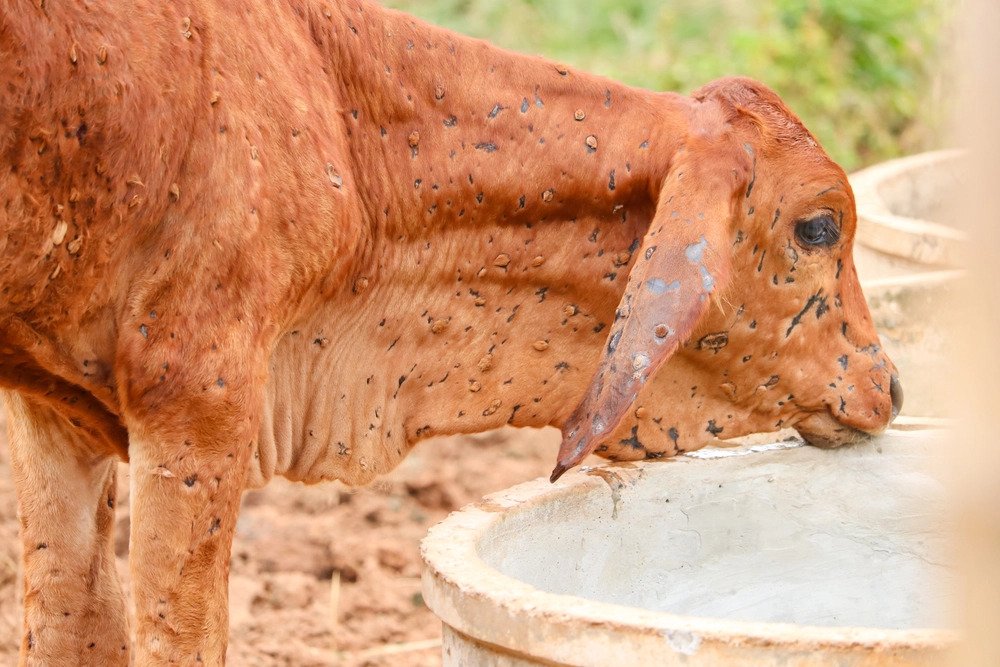
Lumpy skin disease (LSD) is a highly contagious viral disease of cattle that has caused significant economic losses in many countries. In Nepal, the first case of LSD was reported on June 24, 2020, in the Morang district of Koshi province and since then there have been sporadic outbreaks throughout the country.
According to World Organisation for Animal Health (OIE) 2020, the Morang district reported around 3,000 susceptible cattle with 500 positive cases and 12 mortalities, and 5,000 susceptible cattle with positive cases of 700. No mortality was reported in the Chitwan district. Likewise, the Rautahat district encountered 400 susceptible cattle, among them, 12 were positive with zero death and the Makawanpur district encountered 5,500 susceptible cattle with 175 cases and zero death.
Overall, LSD is increasing in different parts of Nepal and it has spread to 49 districts.
So what is this problem all about? How can it be solved? Here we explain.
Transmission, clinical signs and preventive measures
LSD is characterised by the development of nodular lesions on the skin, which can lead to severe inflammation, fever, enlarged superficial lymph nodes, loss of appetite and reduced milk and meat production in infected animals.
The economic impact of LSD is enormous as it affects both dairy and meat production and can lead to trade restrictions and loss of markets for affected countries.
Biting insects are the most important route of infection to animals. Mosquitoes of the Culex and Anopheles genera are the most important vectors of the virus while ticks of the Hyalomma genus also have a major role in virus transmission.
The virus can be present in the saliva of infected insects, which facilitates transmission to susceptible animals during feeding.
In Nepal, there is a lack of availability of vaccines against lumpy skin disease. And, there is no effective treatment for the disease found till now. The disease remains difficult to control due to its high transmissibility and lack of effective treatments.
The prevention and control of lumpy skin disease can be done by isolation and treatment of sick animals, vector control, applying biosecurity measures restriction of movement and trade of animals as well awareness programmes.
Treatment protocols
Lumpy skin disease is a viral disease there is no specific treatment present till now. For its treatment, prevention by means of vaccination is the only method to control lumpy skin disease epidemics. The only treatment available till now is supportive care for cattle. Various treatment protocols (Allopathic drugs or herbal solutions) can be used in its treatment as given below. Note that a veterinary doctor should always be consulted for specific guidance on the appropriate treatment for individual animals.

1. Use of allopathic drugs
Allopathic drugs are used for the symptomatic treatment of animals suffering from LSD. It includes the administration of anti-inflammatory drugs, antibiotics and antihistamines to manage clinical signs such as inflammation, fever, enlarged lymph nodes and nodular lesions and prevent secondary bacterial infection.
- Antibiotics: Antibiotics may be used to prevent secondary bacterial infection. The common broad-spectrum antibiotics used are oxytetracycline, penicillin and fluoroquinolones. Antibiotics are used for 5-7 days continuously.
- Antihistamine: Chlorpheniramine maleate is an antihistamine medication used to help alleviate itching and other allergic reactions.
- NSAID: Meloxicam and flunixin meglumine are no steroidal anti-inflammatory drugs (NSAID). They are commonly used in the management of pain, fever as well as inflammation in animals suffering from lumpy skin disease.
- Ivermectin is used for both endo and ectoparasite eradication.
- Intravenous fluids: Intravenous fluids may be administered to keep the infected animals well-hydrated, particularly if they are experiencing fever or dehydration.
2. Use of herbal solutions
There are various herbal animal health solutions that offer a supportive role in the management of LSD.
Methylene blue in the treatment
The use of conventional supportive treatment alone is found to be ineffective due to antimicrobial resistance and other factors in the treatment of lumpy skin disease in Nepal. According to various research reports, methylene blue is effective in the treatment of lumpy skin disease in cattle and buffaloes if used with supportive treatment either with allopathic or herbal medicines.
Methylene blue (MB) is a broad-spectrum antiviral drug known for its antiviral properties against many diseases. MB helps in the treatment of LSD by reducing the viral load of infected cattle through its multiple mechanisms of antiviral action.
MB also prevents damage to the immune system until the body activates the immune system. Methylene blue reduces infectious viruses in cattle, helps treat various skin diseases and protects the body by preventing multiple organ damage. It promotes faster healing and reduces mortality. It is also used as an antiseptic because of its antifungal and antibacterial properties.

Source: Macsen lab
Several studies have been conducted regarding the treatment protocol used for LSD. A study was conducted by El-Sheikh et al to evaluate the efficacy of methylene blue in controlling LSD in cattle. The study concluded that methylene blue treatment results in a significant reduction in the clinical signs of LSD as well a decrease in the duration of the disease in comparison to the control group of cattle.
Another study by Kawther written in the article —The Role of Some Photosensitisers in Photodynamic Control of Lumpy Skin Disease—concluded methylene blue has photodynamic action against the lumpy skin disease virus.
Use of MB in Nepal
Researchers elsewhere are using the MB treatment protocol with great success, but in Nepal’s case, this needs to be further investigated to find out the efficacy of methylene blue in the treatment of lumpy skin disease.
If methylene blue is proven effective in the treatment of LSD, it could have a significant impact on the health and well-being of animals as well it will be very useful for low-income generating farmers because of its cost-effectiveness and wide range of benefits as a single ingredient. Thus research on this topic is needed to find out the efficacy of the drug.
























